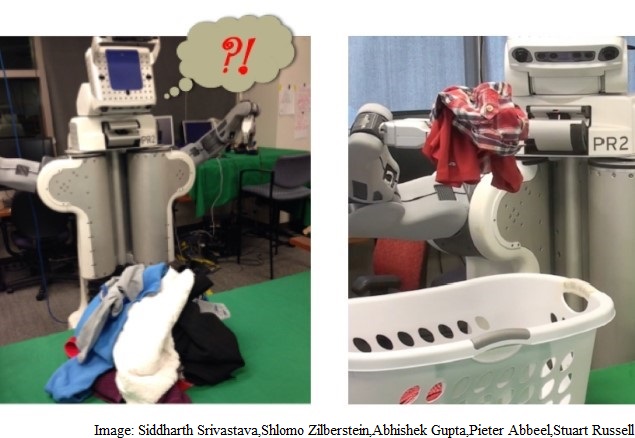- Home
- Science
- Science News
- Now, a Robot to Do Your Laundry
Now, a Robot to Do Your Laundry

The researchers enabled the robot to do the laundry without knowing how many and what type of clothes needed to be washed.
"The widely imagined helper robots of the future are expected to 'clear the table,' 'do laundry' or perform day-to-day tasks with ease," said Siddharth Srivastava, a scientist at the United Technologies Research Center, Berkeley.
The researchers' key insight was to use human behaviour - the almost unconscious action of pulling, stuffing, folding and piling - as a template, adapting both the repetitive and thoughtful aspects of human problem-solving to handle uncertainty in their computed solutions.
Out of the 13 or so tasks involved in the laundry problem, the team's system was able to complete more than half of them autonomously and nearly completed the rest - by far the most effective demonstration of laundering for artificial intelligence (AI) to date, the researches noted.
The framework that Srivastava and his team developed combines several popular planning paradigms that have been developed in the past using complex control structures such as loops and branches and optimises them to run efficiently on modern hardware.
It also incorporates an effective approach for computing plans by learning from examples, rather than through rigid instructions or programmes.
Srivastava presented the robot at the recently concluded Association for Advancement of Artificial Intelligence conference in Austin, Texas.
For the latest tech news and reviews, follow Gadgets 360 on X, Facebook, WhatsApp, Threads and Google News. For the latest videos on gadgets and tech, subscribe to our YouTube channel. If you want to know everything about top influencers, follow our in-house Who'sThat360 on Instagram and YouTube.
Related Stories
- Samsung Galaxy Unpacked 2025
- ChatGPT
- Redmi Note 14 Pro+
- iPhone 16
- Apple Vision Pro
- Oneplus 12
- OnePlus Nord CE 3 Lite 5G
- iPhone 13
- Xiaomi 14 Pro
- Oppo Find N3
- Tecno Spark Go (2023)
- Realme V30
- Best Phones Under 25000
- Samsung Galaxy S24 Series
- Cryptocurrency
- iQoo 12
- Samsung Galaxy S24 Ultra
- Giottus
- Samsung Galaxy Z Flip 5
- Apple 'Scary Fast'
- Housefull 5
- GoPro Hero 12 Black Review
- Invincible Season 2
- JioGlass
- HD Ready TV
- Laptop Under 50000
- Smartwatch Under 10000
- Latest Mobile Phones
- Compare Phones
- Moto G15 Power
- Moto G15
- Realme 14x 5G
- Poco M7 Pro 5G
- Poco C75 5G
- Vivo Y300 (China)
- HMD Arc
- Lava Blaze Duo 5G
- Asus Zenbook S 14
- MacBook Pro 16-inch (M4 Max, 2024)
- Honor Pad V9
- Tecno Megapad 11
- Redmi Watch 5
- Huawei Watch Ultimate Design
- Sony 65 Inches Ultra HD (4K) LED Smart TV (KD-65X74L)
- TCL 55 Inches Ultra HD (4K) LED Smart TV (55C61B)
- Sony PlayStation 5 Pro
- Sony PlayStation 5 Slim Digital Edition
- Blue Star 1.5 Ton 3 Star Inverter Split AC (IC318DNUHC)
- Blue Star 1.5 Ton 3 Star Inverter Split AC (IA318VKU)

















